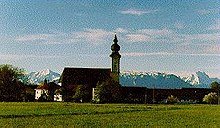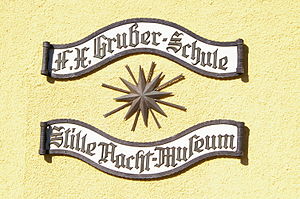Arnsdorf (municipality of Lamprechtshausen)
Arnsdorf is a cadastral municipality belonging to the municipality of Lamprechtshausen in the Austrian state of Salzburg .
In the town in the Salzburg area you will find Maria im Mösl, an old pilgrimage church of Mary and the longest-serving primary school building in Austria. It is believed that in the Middle Ages there was a common place of execution for the courts of Eching and Haunsberg (today's judicial district of Oberndorf ) in Arnsdorf . From 1807–1829, Franz Xaver Gruber , the composer of the Christmas carol Silent Night, lived in the Arnsdorf schoolhouse .
geography
The cadastral municipality of Arnsdorf has around 7.4 km² and is about 20 km north of the provincial capital Salzburg . It is divided into the villages of Loipferding and Niederarnsdorf to the west and Oberarnsdorf, Schmieden and Nopping to the east of the Arnsdorf parish church. Due to their immediate geographic proximity, Oberarnsdorf and Niederarnsdorf are generally perceived as a single village. Accordingly, the common settlement area is also marked with the Arnsdorf town signs .
The place borders on the following other cadastral communities:
| Bürmoos Municipality of Bürmoos |
Lamprechtshausen Municipality of Lamprechtshausen |
St. Alban municipality of Lamprechtshausen |
| Jauchsdorf municipality of Sankt Georgen near Salzburg |

|
St. Alban municipality of Lamprechtshausen |
| Oberndorf Municipality of Oberndorf near Salzburg |
Göming Municipality of Göming |
Nussdorf Municipality of Nussdorf am Haunsberg |
Arnsdorf lies in the foothills of the Alps ; Most of the area is slightly hilly and used for agriculture, around a quarter of the total area - especially in the west and northwest towards Bürmoos - is forested. There are no nature reserves or larger bodies of water; all streams drain into the Salzach . Part of the area in the south is a drinking water reserve .
Culture
Franz Xaver Gruber lived and worked in Arnsdorf from 1808 to 1829 as a teacher, messner and church musician. The son of a poor linen weaver family from the Upper Austrian stronghold-Ach is the composer of the Christmas carol Silent Night, Holy Night . On the upper floor of the Arnsdorf schoolhouse, in which Gruber worked and lived, which is still in its original condition, the Silent Night Museum has been set up since 1956 , giving an insight into his time. On the 100th anniversary of Gruber's death in 1963, a Silent Night fountain was built in front of the house and in 1993 the forecourt was inaugurated as Silent Night Square . The school building is considered to be the oldest school building in Austria in which teaching is still held.
The Maria im Mösl chapel, first mentioned in a document in 1241/42, was located in Niederarnsdorf . The place has been subordinate to the Michaelbeuern Benedictine Abbey since the 13th century . Today's Maria im Mösl church dates from the 15th to 17th centuries. The place has been a pilgrimage destination for almost 800 years and one of the oldest Marian pilgrimage sites in Austria. To this day there is a tradition that every newly elected Archbishop of Salzburg goes on a foot pilgrimage to Our Lady on the Mösl .
The film director Axel Corti lived and worked for many years in the old rectory of Arnsdorf .
traffic
Arnsdorf is located on Lamprechtshausener Straße (B 156) from Salzburg to Braunau am Inn . In addition, the place is connected to the railway network via the Salzburg – Lamprechtshausen railway line. This is operated by Salzburg AG , is integrated as line S1 into the network of the Salzburg S-Bahn and runs every 30 minutes.
Personalities
People related to the place:
- Franz Xaver Gruber (1787–1863), Austrian composer , creator of the world's most famous Christmas carol Silent Night, Holy Night
- Axel Corti (1933–1993), Austrian film director , lived in Arnsdorf
Web links
- Silent Night Museum Arnsdorf
- The Silent Night Place Arnsdorf
- Lamprechtshausen
- Information on the Maria im Mösl church at bergfex.at
Individual evidence
- ↑ Heinz Dopsch (Ed.): Law and Administration . In: History of Salzburg. Stadt und Land , 2nd improved edition, Salzburg 1983, Volume I, Part 2, p. 922.
Coordinates: 47 ° 58 ' N , 12 ° 57' E





